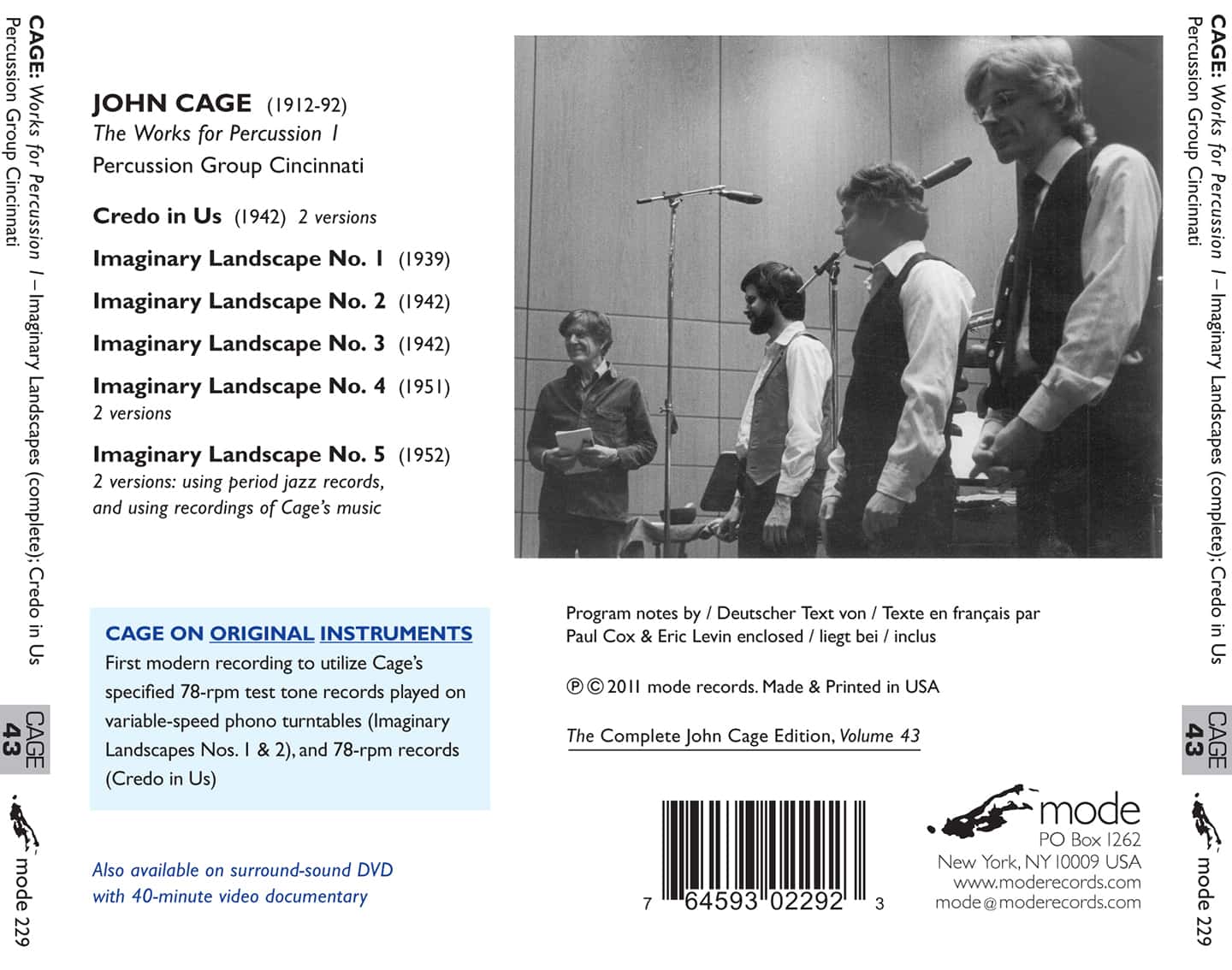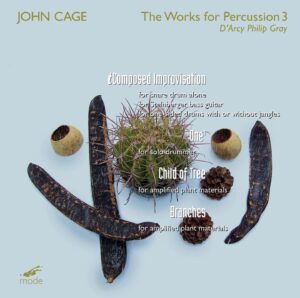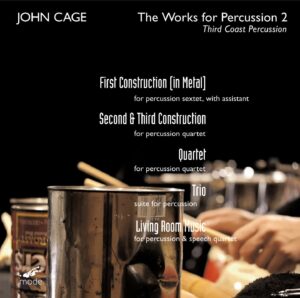The Works for Percussion 1
Imaginary Landscapes (complete); Credo in US (2 versions)
Percussion Group Cincinnati
mode 229
1. CREDO IN US (1942) 12:58
for percussion quartet (including piano and radio or phonograph
First version
With Dmitri Shostakovich: Symphony No.5
2. IMAGINARY LANDSCAPE No. 5 (1952) 3:09
for any 42 recordings, score to be realized as a magnetic tape
First version, using period jazz records. Realization by Michael Barnhart
3. IMAGINARY LANDSCAPE No. 4, “March No. 2” (1951) 4:26
for 12 radios. First version
CCM Percussion Ensemble, James Culley, conductor
4. IMAGINARY LANDSCAPE No. 1 (1939) 6:52
for 2 variable-speed turntables, frequency recordings, muted piano and cymbal, to be performed as a recording or broadcast
With Joey Van Hassel
5. IMAGINARY LANDSCAPE No. 2, “March No. 1” (1942) 6:49
for percussion quintet
6. IMAGINARY LANDSCAPE No. 3 (1942) 4:06
for percussion sextet
With Matthew Hawkins, Mark Katsaounis, Jason Mraz
7. IMAGINARY LANDSCAPE No. 4, “March No. 2” (1951) 4:29
Second version
CCM Percussion Ensemble, James Culley, conductor
8. IMAGINARY LANDSCAPE No. 5 (1952) 3:07
Second version, using recordings of Cage’s music. Realization by Michael Barnhart
9. CREDO IN US (1942) 15:00
Second version
With 78-rpm recordings of Beethoven, Tchaikovsky, Wagner, and von Suppe
CAGE ON ORIGINAL INSTRUMENTS: First modern recording to utilize Cage’s specified 78-rpm test tone records played on variable-speed phono turntables (Imaginary Landscapes Nos. 1 & 2), and 78-rpm records (Credo in US).
Cage’s percussion works are among his most historically important. After 42 Volumes in Mode’s Cage Edition, Mode is releasing the first volume dedicated to his percussion music.
Percussion Group Cincinnati is particularly respected for its knowledge of and experience with the entire range of John Cage’s music, having made tours and festival appearances with him on a number of occasions in Europe and in America, and having had pieces created by Cage especially for the Group.
Volume 1 consists of the complete Imaginary Landscapes 1-5 (1939-52) and Credo in US (1942). Some of these works’ revolutionary features include the use of radios and phonograph recordings — anticipating the concept of sampling.
Credo in US is scored for a pianist, two percussionists playing muted gongs, tin cans, electric buzzer and tom-toms, and a fourth performer operating a radio and phonograph. Two performances are included here, one with the phonograph featuring Beethoven and other composers (from 78-rpm records), the other Shostakovich (from LP).
Imaginary Landscape #1 (1939) is scored for muted piano, cymbal, radio and Test-Tone records to be played on a variable speed turntable. The actual records and turntable specified in the score were located and used for this recording.
Imaginary Landscape #4 (1942) requires 12 radios and conductor. It’s meticulous score specifies dynamics and frequencies yet the result will always be different, subject to what is broadcast at that time: music, talk, noise, static and silence.
Imaginary Landscape #5 (1952) is made from a collage of fragments from (LP) records, recorded on tape. There are eight tracks, made from 42 selected records. Duration and amplitude are notated but there is no indication of what records (or what kind of music) should be used. Two versions are given here: one with jazz recordings (as in Cage’s original), the second using Cage recordings from Mode’s Edition.
Program notes by Paul Cox and Eric Levin.
DVD EDITION contains the above plus:
• “Landscapes : Credo”, Percussion Group Cincinnati presents a video documentary/demonstration of Cage’s unusual instrumentation, techniques, vari-speed turntables and test-tone records. Plus performance excerpts. (40 minutes)
• Dolby & DTS 5.1 surround and dedicated stereo mixes.
• Audiophile quality 96 khz/24-bit PCM stereo tracks.
• DVD BONUS: Imaginary Landscape No. 1, in an authentic recreation of the 1939 original radio station performance directed by Eric Levin. (accompanied with photos from the recording session, stereo)
• DVD BONUS: Imaginary Landscape No. 4, third version (no video)
NOTE: There is no video with the music tracks.





